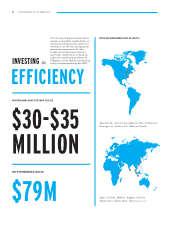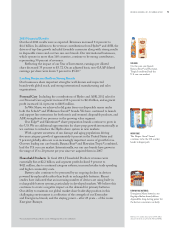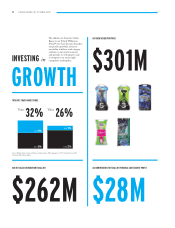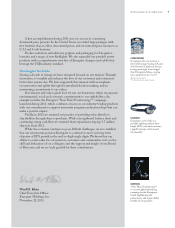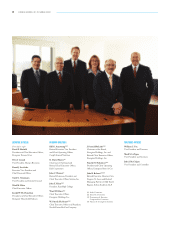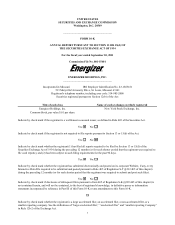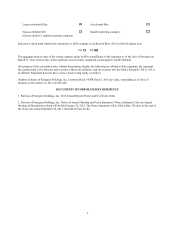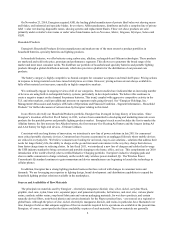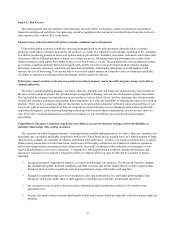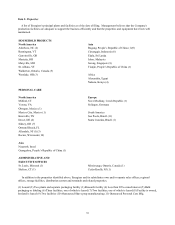Energizer 2011 Annual Report Download - page 16
Download and view the complete annual report
Please find page 16 of the 2011 Energizer annual report below. You can navigate through the pages in the report by either clicking on the pages listed below, or by using the keyword search tool below to find specific information within the annual report. On November 23, 2010, Energizer acquired ASR, the leading global manufacturer of private label/value wet shaving razors
and blades, and industrial and specialty blades. In wet shave, ASR manufactures, distributes and sells a complete line of private
label / value wet shaving disposable razors, shaving systems and replacement blades. These wet shave products are sold
primarily under a retailer's store name or under value brand names such as Personna, Matrix, Magnum, Mystique, Solara and
GEM.
Household Products
Energizer's Household Products division manufactures and markets one of the most extensive product portfolios in
household batteries, specialty batteries and lighting products.
In household batteries, we offer batteries using carbon zinc, alkaline, rechargeable and lithium technologies. These products
are marketed and sold in the price, premium and performance segments. This allows us to penetrate the broad range of the
market and meet most consumer needs. We distribute our portfolio of household and specialty batteries and portable lighting
products through a global distribution network, which also provides a platform for the distribution of our personal care
products.
The battery category is highly competitive as brands compete for consumer acceptance and retail shelf space. Pricing actions
in response to rising material costs have raised retail prices over time. However, pricing actions are not always available to
fully offset material cost increases, especially in highly competitive markets.
We continually engage in ongoing reviews of all of our categories. Recent studies have indicated that an increasing number
of devices are using built-in rechargeable battery systems, particularly in developed markets. We believe this continues to
create a negative impact on the demand for primary batteries. This trend, coupled with aggressive competitive activity in the
U.S. and other markets, could put additional pressure on segment results going forward. See “Energizer Holdings, Inc. -
Management's Discussion and Analysis of Results of Operations and Financial Condition - Segment Information - Household
Products” for further discussion of actions taken by Energizer relating to this trend.
In an effort to diversify our Household Products portfolio, Energizer has leveraged its long history of innovation. Since
Energizer's invention of the first D cell battery in 1893, we have been committed to developing and marketing innovative new
products for the portable power and portable lighting products market. Energizer's track record includes the first to market the
Alkaline battery, the first mercury-free Alkaline battery, the first mercury-free Hearing Aid battery and the longest lasting AA
and AAA battery for high-tech devices - Ultimate Lithium.
Consistent with our long history of innovation, we introduced a new line of power solutions in late 2011 for consumers'
most critical portable electronic devices. Consumers have become accustomed to an unplugged lifestyle where mobile devices
are critical in everyday life. We believe consumers are looking for universal, easy-to-use solutions - solutions that address their
needs for longer battery life, the ability to charge on the go and increased convenience in the way they charge their devices,
from faster charge times to reducing clutter. In late fiscal 2011, we introduced a new line of chargers and cables that leverage
the USB industry standard to bring convenient and portable charging to the home, office, and car. This complements our 2010
introduction of the world's first Qi (chee)-certified Inductive Charging portfolio. Energizer's inductive charging pads and
sleeves enable consumers to charge wirelessly on the world's only wireless power standard, Qi. The Wireless Power
Consortium's Qi standard continues to gain momentum and device manufacturers are beginning to launch this technology in
cellular phones.
In addition, Energizer has a strong lighting products business that has evolved with changes in consumer tastes and
demands. We are leveraging our expertise in lighting design, brand development and distribution capabilities to expand the
household lighting product solutions available in the marketplace.
Sources and Availability of Raw Materials
The principal raw materials used by Energizer - electrolytic manganese dioxide, zinc, silver, nickel, acetylene black,
graphite, steel cans, nylon, brass wire, separator paper, and potassium hydroxide, for batteries, and steel, zinc, various plastic
resins, synthetic rubber resins, soap based lubricants and various packaging materials, for wet shave products, and certain
naturally derived fibers, resin-based plastics and certain chemicals for the Playtex product lines, - are sourced on a regional or
global basis. Although the prices of zinc, nickel, electrolytic manganese dioxide, and resins, in particular, have fluctuated over
time, Energizer believes that adequate supplies of the raw materials required for its operations are available at the present time.
Energizer, of course, cannot predict the future availability or prices of such materials. These raw materials are generally
6


